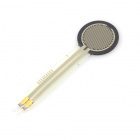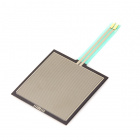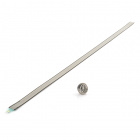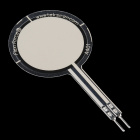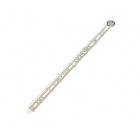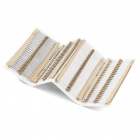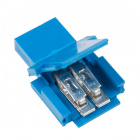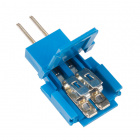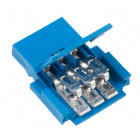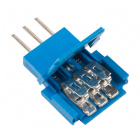Contributors:
 jimblom
jimblom,
 bboyho
bboyho Introduction
Force-sensitive resistor's (FSR) are easy-to-use sensors designed for measuring the presence and relative magnitude of localized physical pressure.
SEN-09375
This is a force sensitive resistor with a round, 0.5" diameter, sensing area.
SEN-09376
This is a force sensitive resistor with a square, 1.75x1.5", sensing area.
SEN-09673
This is a small force sensitive resistor. It has a 0.16" (4 mm) diameter active sensing area.
SEN-09674
This very long force sensitive resistor - over 2 feet - has a sensing area of 0.25x24".
SEN-11207
This is a [piezoresistive](http://www.google.com/url?sa=t&ct=res&cd=1&url=http%3A%2F%2Fen.wikipedia.org%2Fwiki%2FPiezoresisto…
SEN-08685
This is a [piezoresistive](http://www.google.com/url?sa=t&ct=res&cd=1&url=http%3A%2F%2Fen.wikipedia.org%2Fwiki%2FPiezoresisto…
SEN-08713
This is a [piezoresistive](http://www.google.com/url?sa=t&ct=res&cd=1&url=http%3A%2F%2Fen.wikipedia.org%2Fwiki%2FPiezoresisto…
SEN-08712
This is a [piezoresistive](http://www.google.com/url?sa=t&ct=res&cd=1&url=http%3A%2F%2Fen.wikipedia.org%2Fwiki%2FPiezoresisto…
The resistance of an FSR varies as the force on the sensor increases or decreases. When no pressure is being applied to the FSR, its resistance will be larger than 1MΩ. The harder you press on the sensor’s head, the lower the resistance between the two terminals drops. By combining the FSR with a static resistor to create a voltage divider, you can produce a variable voltage that can be read by a microcontroller's analog-to-digital converter.
Suggested Materials
This tutorial serves as a quick primer on FSR's and demonstrates how to hook them up and use them. Beyond a FSR of your choice, the following materials are recommended:
Arduino Uno -- We'll be using the Arduino's analog-to-digital converter to read in the variable resistance of the FSR. Any Arduino-compatible development platform -- be it a RedBoard, Pro or Pro Mini -- can substitute.
Resistor Kit -- To turn the FSR's variable resistance into a readable voltage, we'll combine it with a static resistor to create a voltage divider. This resistor kit is handy for some trial-and-error testing to hone in on the most sensitive circuit possible.
Breadboard and Jumper Wires -- The FSR's terminals are breadboard-compatible. We'll stick in that and the resistor, then use the jumper wires to connect from breadboard to Arduino.
COM-10969
Nothing stops a project dead in its tracks faster than not having the right resistor. These components are arguably the most …
DEV-13975
The SparkFun RedBoard combines the simplicity of the UNO's Optiboot bootloader, the stability of the FTDI, and the shield com…
PRT-12002
This is your tried and true white solderless breadboard. It has 2 power buses, 10 columns, and 30 rows - a total of 400 tie i…
PRT-11026
If you need to knock up a quick prototype there's nothing like having a pile of jumper wires to speed things up, and let's fa…
Force Sensitive Resistor Adapter -- While the FSR terminals are breadboard-compatible, we've found that it may be loose in the breadboard. For those looking for a way to make a more secure connection without soldering, try looking at the associated Amphenol pin adapters. You will need a pair of needle nose pliers to clamp the the adapter down.
COM-14194
These Clincher connectors from Amphenol FCI can be used to terminate Flat Flexible Cables (FFCs) to an easy-to-use standard h…
COM-14195
These Clincher connectors from Amphenol FCI can be used to terminate Flat Flexible Cables (FFCs) to an easy-to-use standard h…
COM-14196
These Clincher connectors from Amphenol FCI can be used to terminate Flat Flexible Cables (FFCs) to an easy-to-use standard h…
COM-14197
These Clincher connectors from Amphenol FCI can be used to terminate Flat Flexible Cables (FFCs) to an easy-to-use standard h…
Suggested Reading
Analog components, like these FSRs, are a great sensor-reading entry-point for beginners, but there are a few electronics concepts you should be familiar with. If any of these tutorial titles sound foreign to you, consider skimming through that content first.
Voltage Dividers
Turn a large voltage into a smaller one with voltage dividers. This tutorial covers: what a voltage divider circuit looks like and how it is used in the real world.
What is an Arduino?
What is this 'Arduino' thing anyway? This tutorials dives into what an Arduino is and along with Arduino projects and widgets.
Analog vs. Digital
This tutorial covers the concept of analog and digital signals, as they relate to electronics.
